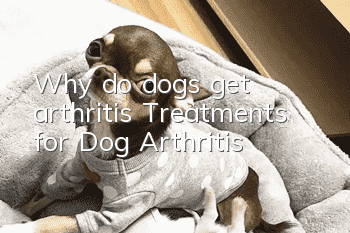Why do dogs get arthritis? Treatments for Dog Arthritis

It is the responsibility of every parent to let every dog move freely! Osteoarthritis in dogs, also known as degenerative joint disease, is a very painful condition. When dog arthrosis is diagnosed, it is generally difficult to completely cure or recover; dog arthrosis is accompanied by joint damage and articular cartilage wear. At this time, calcium supplementation will also be difficult to restore the dog's joints! Therefore, for large dog puppies, please do not supplement calcium at will. Because large dogs grow too fast, please pay attention to the nutritional balance during the growth and development period of the puppies to maintain the coordinated development of bones and joints; for older dogs, please wait until the dog enters the old age ( After the age of 8 for small dogs and after the age of 5-6 for large dogs), it is recommended to feed prescription foods related to joint diseases.
How to identify arthritis in dogs
1. In terms of activities: The amount of activity has decreased sharply. The dog does not like to play. It spends more time lying and resting than usual. It gets tired easily and is unwilling to exercise as usual!
When running, the dog also keeps changing its hind legs. In the early morning, after resting and in cold weather, the dog will move slowly or stiffly. It is unwilling to go upstairs, and it is extremely difficult to climb stairs. It is unwilling to jump in or out of the container and difficult to sleep. Get up!
2. Action: In daily activities, the dog will bark or whine due to pain. When it touches the affected area, the dog will run away, yell or bite, and the dog will If you lick or bite your affected joints, the dog's temperament will change, such as becoming lethargic, depressed or bad tempered, the dog's appetite will decrease or it will not be interested in food!
Disease factors
1. Genetic factors: Dog hip dysplasia is mostly related to genetics! Generally speaking, in foreign countries, if a dog is found to have similar problems, the dog will usually be sterilized to avoid the continued inheritance of bad genes.
2. Nutritional issues: Excessive nutrition and increased calcium absorption may cause an imbalance in body metabolism, thereby inducing the occurrence of hip dysplasia.
3. Environmental factors: If the floor at home is too smooth, puppies often kick their legs inadvertently, causing unnecessary burden on the limbs of the puppies; if large dogs, such as golden retrievers, Labradors, etc. Lack of activity and frequent overfeeding lead to obesity, which can easily cause excessive pressure on joints and lead to the occurrence of arthritis.
Treatment methods
1. Physical therapy to restore the dog’s joint movement ability;
2. Feed a series of prescription foods for joint diseases for life to supplement joint nutrition and enhance joint flexibility; resistThe goal of inflammation treatment is to relieve the dog's pain, eliminate joint inflammation and increase mobility. Non-steroidal anti-inflammatory drugs are currently one of the most commonly used drugs for the treatment of canine arthritis. Dogs' needs vary according to their weight. The dosage of its medication.
3. Hip replacement surgery;
4. If your dog unfortunately suffers from arthritis and is overweight, reducing the weight of the dog can reduce the burden of arthritis, which will make it easy for the dog to move around at will. Methods of reducing weight include dieting, control weight and do regular physical exercise. Obese dogs lose weight and maintain normal weight;
5. Excessive exercise will not only increase the dog’s pain, but also increase the damage to its joints, but inactivity will also delay the dog’s condition, so we need to develop a moderate set of low-intensity exercises for the dog, including Walk or swim for exercise every day.
- How to train a Chow Chow? What should you pay attention to when raising a Chow Chow?
- Japanese Shiba Inu IQ and Shiba Inu personality
- What to do if your dog goes into shock
- Things to note when raising a Satsuma
- Can I beat an Akita dog if it disobeys?
- Dog white sticky eye mucus
- What to do if your dog poops black and loose stools
- Will it be ok if the dog pulls out the roundworms?
- What should dogs eat during pregnancy?
- Dog keeps licking itself after shaving



